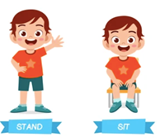Stair climbing is part of our everyday life! Sometimes when children are learning to navigate stairs, it can feel overwhelming and a bit scary. It is important to teach children how to walk up and down stairs safely so they can navigate different environments.
Here are some tips and exercises to help with teaching stair skills.
Safety Tips:
- Make sure you have safety gates on your stairs if you have a child that doesn’t know how to navigate stairs safely and independently.
- Break down the skill into steps (pun intended) and begin with just 3-4 stairs.
- Stand behind your child when they are walking up the stairs.
- Stand in front of your child when they are walking down the stairs.
- Remember, most children learn to walk up stairs before walking down stairs.
Exercises to Promote Stair Climbing:
- Sit-to-stand
Have the child practice sitting on a chair with their feet on the floor, then standing up and sitting back down again. Have them try without using their hands! They can hold onto a favourite toy while they do this. Sit-to-stands will build leg strength that will help with climbing stairs. - Stepping on and off a step stool
Set up a step stool next to a stable, raised surface (e.g. counter). Have the child step up onto the step stool to reach for toys on the raised surface. Then have them turn around and step down. Use a hand hold as needed. - Weight shifting
Practice having the child lean side to side shifting their weight from one foot to the other and back again. - Standing on one foot
Practice standing on one foot. You can hold the child’s hand initially or have them hold onto a stable surface. Similarly, they can rest one foot on a small ball or step. As this gets easier, remove the supports. - Bicycle kicks (or marching on the spot)
Have the child lay on their back. Gently hold their ankles and pump their legs back and forth as if they were pedalling a bike. This will help promote the reciprocal action that we look for as a long-term stair goal. Alternatively, encourage the child to march on the spot. Try pairing movements with verbal cues “1,2,1,2”.


Stair Practice:
Step-to Pattern
This is when one foot leads and the other foot steps up to the stair to meet it. For example, right foot steps up, left foots meets it, right foot steps up, left foot meets it.
- Start with a few stairs at a time. Encourage the child to hold onto a railing. If needed, provide a hand hold and/or gently support them at their trunk.
- Start with having the child place one foot and then the other onto the step. Take a moment and then do the same on the next step.
- Use verbal cues (e.g. ‘step, together, step, together’) to promote movement or gently tap/guide the child’s leg so they know which foot is supposed to move next.
- Make sure the child practices leading with each foot.
Alternating or Reciprocal Pattern
This is when only one foot is placed on each step. The leading foot alternates on each step.
- Again, start with a few stairs at a time. Encourage the child to hold onto a railing.
- Use verbal cues (e.g. “1,2,1,2”) to encourage movement or guide the child’s leg to the appropriate step.
- You can use visuals for additional help. For example, place coloured dots or footprint cut-outs on the stair treads. This provides a visual cue of where to place foot and which foot is expected to move next.
It helps to practice stairs in different environments, at school, at home, on the playground, outside a building.

